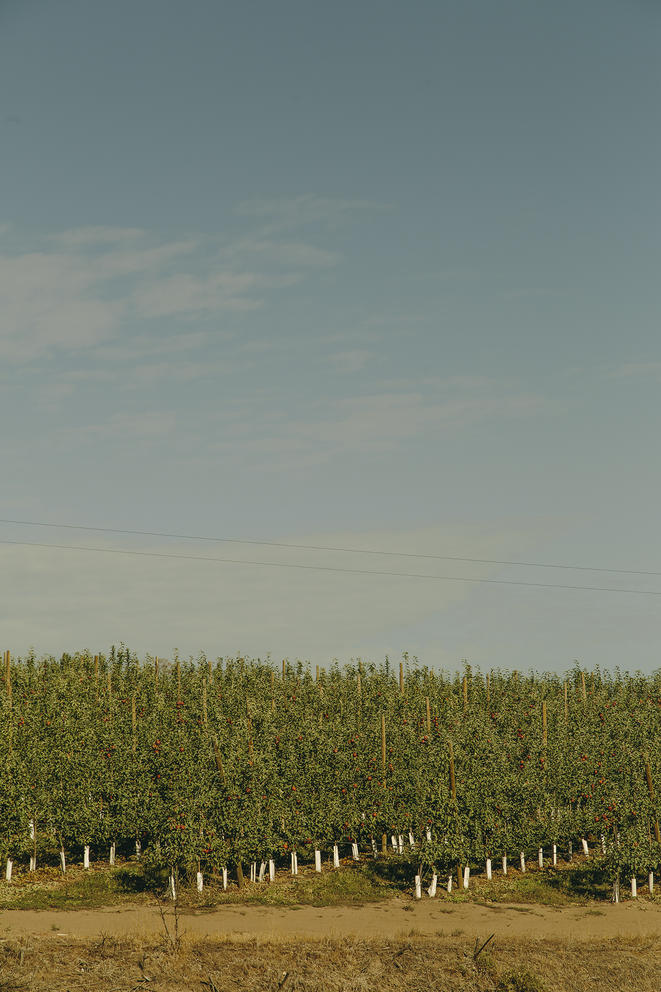Indeed, Cosmic Crisp, which had been under development for some two decades through the Washington State University breeding program, received robust national press prior to its December 2019 commercial launch. Stories highlighted its crisp texture and sweet flavor and its ability to retain taste and texture for many months, making it ideal for stocking grocery stores year-round.
In the fall of 2019, nearly 14 million Cosmic Crisp apples were available nationwide, a small fraction of the more than 5.3 billion fresh apples harvested in Washington state that fall. All the Cosmic Crisps were gone within months, and the first season wrapped up in February 2020, around the time the pandemic halted in-store food marketing, such as apple tastings.
Bags of apples became popular as curbside pickup increased and in-store opportunities for exposure to new varieties declined. Meanwhile, the pandemic, racial injustice and the 2020 election dominated the news cycle more than food trends did.
“It was a real shock going from $50 million of earned media to the media no longer talking about anything but the pandemic, the election and social unrest,” said Kathryn Grandy, chief marketing officer of Proprietary Variety Management, the Yakima firm that marketed Cosmic Crisp and several other new varieties.
The pandemic added to the apple industry’s ongoing challenge getting consumers on board with new varieties after decades of dominance by Red Delicious. Just two decades ago, Red Delicious made up nearly half of the Washington state crop. Now the variety is expected to make up just 15% of this year’s crop.
New varieties also have the task of rekindling excitement in a fruit that, while ubiquitous, has been in the shadow of other produce items.
“There’s an awful lot of competing fruit,” said Des O’Rourke, principal of Belrose Inc., a global fruit marketing analysis firm in Pullman. “[Consumers have] frozen their consumption of traditional fruits like apples, pears and oranges and trying more exciting, new and different tastes.”
Like many others, Mark Barrett, owner of Barrett Orchards in Yakima, has invested millions in growing Cosmic Crisp. Barrett sells the variety at his stand, Washington Fruit Place, and sends fruit to a warehouse that ships them to retailers nationwide.
“When we made the investment, the hope [was that] we would get our money back within five years,” Barrett said. “I would say it’s delayed. Hopefully, it’s not 10 [years]. I’m still bullish enough to think it’s going to be eight or something.”
Chasing Honeycrisp’s success
Cosmic Crisp is just one of many new varieties that growers and others in the apple industry look to replicate the success of Honeycrisp, an apple developed at the University of Minnesota that has seen massive growth in the past decade.
“The introduction of Honeycrisp apples 15 years ago kicked off a quest for new and exciting apples,” said Catherine Gipe-Stewart of Domex Superfresh Growers, a Yakima-area firm that grows and ships a variety of fruit, including apples. “This has been happening across all product categories in the grocery store; think of the innovation in beer, snacks, teas and even meat.”
Still, U.S. consumers could only name three varieties – Gala, Red Delicious and Granny Smith – according to a consumer survey from AgroFresh. The company provides various growing and storage solutions for the produce industry.
That survey also said 86% of consumers were satisfied with the apples they buy. But such customer satisfaction hasn’t translated into their eating more apples. In 1989, per capita consumption was more than 21 pounds a year. Three decades later, in 2019, that figure dropped to about 17 pounds, according to the latest statistics from the U.S. Department of Agriculture’s Economic Research Service.
Meanwhile, over that same period, consumers increased their consumption of other fruits, such as fresh strawberries and avocados. In 1989, per capita consumption of strawberries and avocados were about 3.3 pounds and 1.1 pounds, respectively. That increased to 5.8 pounds and 7.9 pounds three decades later.
Some in the industry worry that if consumers don’t increase their apple consumption, new apple varieties and those that grow and promote them will be competing for retail shelf space.
“If we do not increase consumption, something’s got to give. I don’t like that scenario,” said Chuck Zeutenhorst, president of FirstFruits Marketing, a Yakima fruit marketing firm that sells fruit on behalf of several orchards. “I’d much rather figure out the consumption problem.”
About three-quarters of the 6.8 billion fresh apples harvested, packed and shipped in the U.S. in 2020 came from Washington state, according to U.S. Department of Agriculture figures.
And for decades, the bright red-skinned Red Delicious was the face of the apples grown in Washington state, making up about 60% of the state’s crop.
Today, most of the now much smaller Red Delicious crop are exported. According to estimates from the Washington State Tree Fruit Association, just over 779 million Red Delicious apples are expected to be harvested and shipped during the 2021-2022 season, or about 15.6% of the nearly 5 billion pounds of fresh apples harvested in the state.
Gala surpassed Red Delicious as the top volume variety several years ago, now making up about 21% of this year’s fresh apple crop, according to tree fruit association estimates.
And Honeycrisp is close to passing Red Delicious. The variety was developed three decades ago, but Washington growers started commercially producing the variety in 2006. That year, it made up just 0.6% of the state’s fresh apple crop. Fifteen years later, it makes up about 14% of the 2021 fresh crop or nearly 700 million pounds.
Honeycrisp’s growth in this state hasn’t been without roadblocks — the apple has been challenging to grow, and often significant portions of a crop have been unsuitable for retail sale.
But growers have been willing to weather the challenges if it means capitalizing on the variety’s success with consumers.
“Honeycrisp is one of those things you work hard on for 30 years, and then you’re an overnight success,” said Jon DeVaney, president of the Washington State Tree Fruit Association.
Marketing push
The Washington state apple industry has been without a centralized domestic promotion program since 2003, part of a settlement of a court case regarding whether it was constitutional for the Washington Apple Commission to charge a grower assessment for promotions.
As a result, individual fruit companies conduct their own marketing in the United States. The Washington Apple Commission continues to do promotions for the industry internationally.
O’Rourke, the world apple market analyst from Belrose Inc., said that decision has limited consumer reach.
Cosmic Crisp had a multimillion marketing budget, but that’s a fraction of the tens of millions companies spend promoting processed food products, O’Rourke said.
“The question really is, ‘How does the apple industry get a bigger share of the consumer’s diet?’ ” O’Rourke said, noting the competition among other produce and snack foods.
Still, many point to the initial buzz about Cosmic Crisp two years ago as an example of a successful and coordinated marketing push.
The campaign “did a phenomenal job getting the name Cosmic Crisp in people’s brains,” said Mac Riggin, director of marketing at Chelan Fresh, a Chelan firm that sells fruit on behalf of growers throughout the state.
Gipe-Stewart of Domex Superfresh Growers points to statistics from Nielsen that show that Cosmic Crisp ranks 11th in sales among all apples in the U.S. after just two years.
The variety is expected to make up 2.6% of the state’s fresh apple crop in 2021, according to estimates from the Washington State Tree Fruit Commission. Cosmic Crisp reached that milestone in three years, compared with five years for Honeycrisp.
In lieu of in-store sampling, fruit marketers have developed new strategies to promote their brands, including offering sample boxes of individual apples with curbside and deliveries. Boxes of individual Cosmic Crisp, for example, included a QR code that led to a website with information, grower stories and recipes.
Either kind of promotion — in-person tasting or sample boxes — make the case to shoppers for an excellent eating experience if they take a chance on a new variety.
The growers need to take it from there, marketers say.
“The apples that we are putting in front of the consumer [should] give them an exceptional eating experience every time,” said Zeutenhorst of FirstFruits Marketing.
That can be a challenge, given that apples aren’t made on a factory line but outdoors, where weather and other conditions can alter their shape, size and taste.
Cosmic Crisp’s was promoted as an apple designed to grow in Washington state specifically and by nature would be easier to grow than Honeycrisp.
Barrett, the Yakima grower, said Cosmic Crisp has been easier to grow than Honeycrisp, but it isn’t without challenges. For one, he found that it was necessary to cut the stems out of each apple, so they don’t pierce the fruit and cause rot. That means extra labor time and increased labor costs.
Grandy of Proprietary Variety Management noted several issues that have been addressed through continued research from WSU, such as best storage times for developing flavor.
Having all growers follow best practices is crucial to success in the produce aisle, which includes living up to the promise of a great eating experience, she said.
“Our growers depend on us to come up with the best marketing program, and we depend on them to develop the best product,” she said.
Getting, and staying, in the produce aisle
According to the Washington State Tree Fruit Association, roughly 70 different apple varieties are commercially shipped out of Washington state. The Washington Apple Commission lists more than 30 on its website.
While Cosmic Crisp is the most talked about, fruit companies promote several other branded varieties. Chelan Fresh has Sugarbee, an apple bred from a Honeycrisp parent identifiable by its honeycomb logo. FirstFruits promotes the Opal, a bright yellow apple with a crunchy texture. Domex Superfresh Growers has Autumn Glory, a sweet apple with cinnamon and caramel notes.
Only a handful of varieties have enough volume for a core presence in stores: Honeycrisp, Gala, Fuji, Granny Smith, Red Delicious and Pink Lady, said Gipe-Stewart of Domex Superfresh Growers.
Cosmic Crisp is set to join that group as volumes are expected to increase considerably in the next several years, providing enough product to stock stores year-round. The Washington Apple Commission already lists it as one of eight core varieties, along with Golden Delicious.
Bethea, the QFC produce merchandiser, said he doesn’t expect new apples to replace legacy varieties right away; there are plenty of customers who still want Granny Smith or Fuji apples.
Fruit marketers say now is the time for other new varieties to gain a foothold in stores, especially as different long-standing varieties, such as Red and Golden Delicious, continue to decline in production.
Barrett, the Yakima grower, has 13 different types of apples. They include everything from Fuji and Gala to newly developed varieties from Europe grown in small qualities.
His fruit stand, which sells a variety of produce items along with home decor and gift items, serves as a testing ground for some newer or less well-known varieties.
He still is bullish on Cosmic Crisp, given the demand he sees from the stand’s customer base, which, through the operation’s online presence, extends beyond the Yakima Valley.
“Our online sales have been predominately Cosmic Crisp in the last two years,” he said. “People call from all over the U.S. They get more and more every year.”
But there’s a reason Barrett grows multiple varieties: All apples sold, not just one or two kinds, need to offer incredible flavor consistently, he said. If that doesn’t occur, apple consumption will remain flat.
“We’ve gone too long of just growing apples as an industry — growing apples that are not always a great eating experience,” he said. “I think some of these new varieties have the capability of [getting] the consumer to buy more.”









